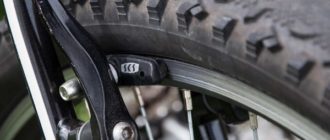The steering column of the bicycle directly affects the quality characteristics and usability of the vehicle. You don’t notice the unit when it’s working properly. When a complex mechanism wears out, problems arise. The variety and incompatibility of steering standards confuses the rider and causes doubts about the correct choice. Proven ways can help you find out what kind of steering columns fit your bike frame and how to install your new device. Modern designs for steering in the right direction have become versatile. They are able to adjust to the model of the bike, riding style and even the physique of the cyclist.
Types of bicycle handlebars
The choice of the main unit begins with determining the type of steering columns. The mechanism consists of a set of components. Each type has its own nuances and characteristics. The options presented on the market sometimes differ significantly, as they are “sharpened” for specific models of bicycles.
According to the form of the speakers are divided into 2 classes:
- Hollow rectangular. The diameter of the tube is the same size at the top and bottom. The device is suitable for all riding styles, from leisurely urban to super-extreme.
- Steering cups are cone-shaped. Narrow tube expands to 1.5″ from the bottom. The “Tapered” configuration withstands all loads and provides the bike with extra durability.
Both varieties are subdivided into 4 types of speakers. The weight of the device, the type of bearings, the material of the cups, the manufacturer’s technical solutions matter.
Threaded
A simple and inexpensive type of steering columns were present on bicycles produced in the former Soviet Union. The lightweight construction is made up of the following parts:
- Two cups pressed into the frame cup;
- closed or open bearings;
- the fork rod with the applied threads;
- a lock nut that tightens the components.
Difficult to adjust knot does not withstand maximum loads, as it is used in recreational two-wheelers. Column (threaded) is recognized by the large size of the parts protruding beyond the frame and the fastening nut located at the top of the steering rack of the bike. The merits of the design include the ability to adjust the height of the handlebar, to adapt to the curved shapes of comfortable road bikes.
Threadless
Aheadset was the first company to introduce a modern type of column. The independent part of the mechanism is characterized by reliability and durability.
Features:
- No nuts or threads in the design.
- Separate positioning of the column and the outrigger.
- There is a new detail – an anchor with a cover.
- Bearings are closed by a rolling ring.
- The column is secured by a steering tube.
The standards for the Aheadset are: forks with a stem diameter of 1-1/8″. Among the advantages of the mechanism installed on most bikes, note the quality of the components, the absence of problems in operation. Reliable column provides a smooth movement, helps to turn safely in any direction. The main plus – there is nothing difficult to install and repair.
Traditional
The most common type of threadless mechanisms – traditional or standard. It is denoted by symbols EC (External Cup).
The design of the bicycle steering column is characterized by the following features:
- the outer cups with bearings are outside the handlebar cup;
- Anchor and ring lock the whole structure;
- the handlebar stem has an irreducible height;
- the bearings are easy to replace when worn;
- the price is lower than analogues.
The design without any disadvantages is installed on road and mountain bikes of different models.
Integrated
Integrated standards are characterized by features that are not present in other types of mechanism:
- the fusion of the steering column and the frame;
- no cups;
- Industrial bearings with a beveled bottom edge;
- “washes” are pressed into the frame;
- no raceway;
- large size variation;
- complicated self-repair.
Advantages: affordable price, easy installation, structural strength. To prevent abrasion, the state of the mechanism is checked once a season.
Semi-integrated
The design of this type is considered the most reliable for professional bikes. Expensive mechanism helps the athlete to choose the height of the handlebar for a particular style of riding, taking into account the physique of the rider. The handlebar (closed type) has no protruding parts, with the exception of the outer rings and the stem. For the Zerostack there are the following standards:
- inside diameter of the cup – 44;
- The rod diameter is 28.6.
Steering column with a tapered stem
On professional bicycles, forks with a stem of the old type have replaced the new standards. The lower diameter of the column is 1 ½ inches and the upper diameter is 1 1/8. The tapered mechanism belongs to the category of threadless steering. Manufacturers decided with the help of a new design to increase the strength of the areas experiencing higher loads. The tube externally resembles a pear and has not changed in size. The tapered cup is called Tapered.
Ordinary cyclists do not need to install a steering column with a tapered stem. The innovation is designed for extreme sports, where you need reliable control at speed, instant braking, stiffness. Thanks to the increase in the steering stem (lower part) the load is distributed evenly, prolonging the time of use of the bearings.
Dimensions and standards
When selecting a bicycle unit, attention is paid to generally accepted standards. For example, it is not recommended to put integrated systems on city bikes that are difficult to maintain. For extreme sports, tapered cups are suitable.
| Type of column | Ratio (inches) | Outer Diameter (mm) | Inner bore diameter (mm) |
|---|---|---|---|
| Threaded | 1″ | 30-30,8 | 26,4-27 |
| Threaded | 1.1/8″ 1.1/4″ |
34 37 |
30 33 |
| Threadless EC32 | 0.833″ | 32,7 | 26,4 |
| EC30 | 1″ | 30,2 | 26,4 |
| EC49 | 1.5″ | 49,7 | 39,8 |
| Semi-integrated ZS41 and ZS44 | 1.1/8″ | 41,3 – 44 | 30 |
| ZS49 | 1.5″ | 49,7 | 39,8 |
| Integrated IS38 | 1 | 38 | 26,4 |
| IS42, 47 | 1.1/8″ | 41,8; 47 | 30 |
Assembly and Repair
Steering columns are installed on the frame by aligning the parts under uniform pressure. The second name of the method is pressing. It is the one that determines the reliability of the bicycle assembly. It is not recommended to use a hammer and a wooden peg for proper installation. Any mistake will lead to a functional failure of the device. Assemble the knot with a special tool. The press consists of a special rod with two nozzles. The device is clamped and evenly pressed inside the cup. Observing the sequence of assembly, do not allow for misalignment.
Steering columns in most cases are placed in cups that are compatible in size. Sometimes cyclists have to install a column of non-standard parameters. To eliminate the error, choose a design that is equal to the diameter of the frame sleeve. In the integrated part is installed the column of the same name. In other glasses – threaded, unthreaded, conventional.
Recommendations for steering cup selection
Because of the difference in the parameters of the columns, the owner of the bike faces the question: how to choose the right kind of construction. A few tips will help make the right purchase.
- Determine the appropriate standard for the bike.
- Measure the diameter of the holes of the handlebar cup.
- The depth of the cups should match the general standard.
- It is advisable to take an old frame to the store to check in place the standards with the seating dimensions.
- Choose steering cups with chamfers placed inside.
- Give preference to a device with pressed cups. “Proms” are stress-resistant and require special care.
- Tapered cups are suitable for extreme riding styles.
- The untrained cyclist is better to buy threaded (classic) designs, as integrated ones are difficult to care for.
- For stunts, sport riding, you need a more durable bike. Choose tapered Tapered at least 1.5 inches.
- Take into account the geometry of the frame. The angle of inclination directly affects the handling of the bike.
- Choose the length of the handlebar cup depending on your riding goals. Short handlebar stacks make the cyclist’s fit low and the ride aggressive. Longer ones are suitable for city models, where you want a high and straight fit.
- Don’t overpay for ceramic bearings. The parts are more expensive than steel, which are not inferior in quality and do not cause serious problems in operation.
Conclusion
A properly selected steering column for the bicycle will save you from worrying about possible breakdowns and ensure safe steering. A reliable mechanism performs invisible work. But the quality of the device determines all the characteristics of the bicycle.











